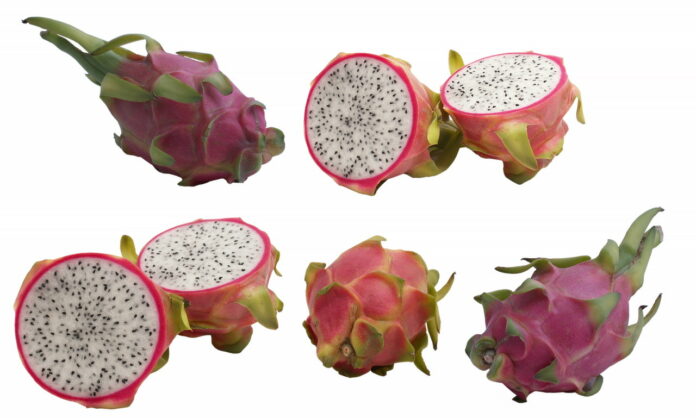Pitahaya (Hylocereus undatus) is an amazing exotic fruit that grows on climbing cacti. The fruit’s skin resembles dragon scales, and it’s no coincidence! In ancient times, people believed pitahaya to be the heart of a mythical creature.
According to legend, to obtain the delicious and juicy fruits, warriors exterminated all the dragons on Earth. However, the remaining amazing dragon fruits thrived, and now we have the opportunity to enjoy them.
South America is considered the birthplace of dragon fruit. Indigenous people valued pitahaya for its low maintenance, fast fruit ripening, ease of harvesting, and the ability to consume it without processing.
Pitahaya is a vine-like cactus plant. The fruit begins to form 1-1.5 months after flowering. After a month, the fruit develops at the site of the flower.
The color of the dragon fruit’s skin and flesh depends on its variety. The weight ranges from 150 to 600 grams. In size, the cactus fruit resembles an apple but has an elongated shape. The fruit is similar to kiwi in texture and the presence of small black seeds in the flesh.
Varieties of Pitahaya:
- Pink with white flesh. Origin: Thailand, Vietnam. Sizes: 8-12 cm.
- Pink with red flesh (Costa Rican). Origin: Mexico. Sizes are approximately the same: 9-12 cm.
- Yellow with white flesh. Origin: Venezuela, Peru, Bolivia, Colombia, Ecuador. Its sizes are more modest: 6-9 cm.
The fruit’s skin is inedible. Usually, the unpeeled fruit is cut in half, and the flesh is eaten with a spoon. But other options are possible. For example, peel the fruit and cut the flesh into cubes or slice it with the peel, like an orange. The flesh can be used to make jelly.
Pitahaya has a vibrant color but a mildly expressed taste. The fruit is moderately sweet, with the taste varying depending on the variety and ripeness. The yellow variety is considered the sweetest. Some liken the taste of the fruit to kiwi, while others find similarities with pear, banana, and strawberry. Chilled fruit tends to have a more pronounced flavor.
Nutritional Properties:
Pitahaya is a delicious fruit with several beneficial properties for the human body:
- Detoxifies the body.
- Normalizes digestive system function.
- Alleviates flatulence.
- Has a mild laxative effect.
- Reduces blood glucose levels and regulates sugar.
- Positively affects the cardiovascular, endocrine systems, and vision.
- Due to its low calorie content, it does not harm the figure.
- Relieves stomach pain.
- Promotes wound healing.
- Has rejuvenating effects.
- Additionally, dragon fruit is actively used in the cosmetic industry, culinary arts, and alcohol production.
Contraindications:
When consuming any product, it’s essential to know moderation, especially with exotic fruits. It’s recommended to start with small portions of pitahaya to identify any possible individual intolerance. Excessive consumption may lead to heartburn, diarrhea, or bloating.
In children under ten years old, pitahaya often triggers diathesis and food allergies.
Note! A person who consumes many fruits with red flesh may notice that their stool and urine turn red. This phenomenon is called “pseudohematuria” and resolves on its own without requiring medical intervention.
Growing Pitahaya at Home:
You can grow dragon fruit at home. While the mature plant requires minimal care, some effort is needed initially to ensure it yields juicy fruits. Here’s what you’ll need:
- Take a ripe fruit. Extract the pulp, soak it in water, and strain it through cheesecloth. Repeat until the seeds are completely free of pulp.
- Prepare the soil: place drainage material in a flower pot and fill it with soil. Make a hole about 1.5 cm deep.
- Plant pitahaya seeds (3-5 pieces) in the hole, cover them with soil, and water.
- Cover the pot with glass or plastic to create the necessary microclimate.
The plant enjoys light and warmth and isn’t afraid of drafts. The recommended temperature for cultivation is +23°C. Watering should be done as needed but not too frequently to avoid overwatering. Seedlings will appear within a week. - Seedlings will be ready for planting in a month. In winter, the plant can withstand temperatures down to 0°C.
- Pitahaya requires cross-pollination, so it’s better to plant two or more plants. The cactus can bloom in the first year, but that doesn’t mean it will start bearing fruit. Sometimes pitahaya only bears fruit 6-7 years after planting.
Interesting facts about pitahaya:
- According to beliefs, a person who tastes pitahaya becomes braver and stronger.
- There are only 50 calories in 100 grams of dragon fruit.
- The first mention of the fruit dates back to the 13th century.
- Ancient Aztecs roasted the seeds and used them to make a porridge.
- Pitahaya blooms only at night, earning it the nickname “moon flower.” The flowering lasts only one night.
- Pitahaya consists of 80% water.
- Tea can be brewed from pitahaya flowers.
- The plant bears fruit year-round.
- Mexicans use pitahaya not only as food but also as a decorative element.
- Before serving, the fruit can be lightly heated to enhance its aroma.
- Pitahaya flowers are large and snowy white.
- Another name for the exotic fruit is “spiky pear.”
- Pitahaya seeds are not digested in the stomach.
- A ripe fruit can be easily identified by its dry scales.
- Dry tropical climates are ideal for dragon fruit.
- The yellow variety of pitahaya is quite rare, so its price is much higher than that of the red variety.
- Thailand is the world’s largest supplier of dragon fruit after Vietnam.
